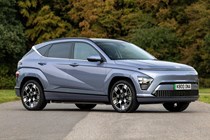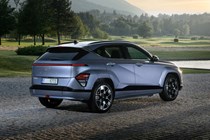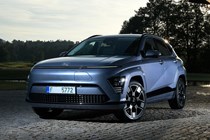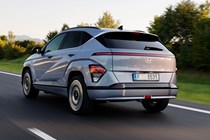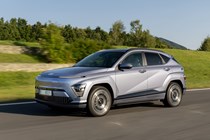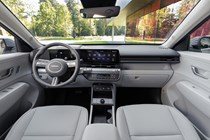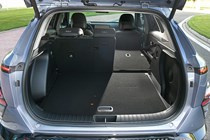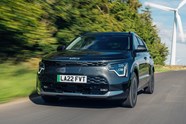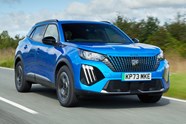
Hyundai Kona Electric review

At a glance
| Price new | £35,000 - £41,900 |
|---|---|
| Used prices | £16,959 - £29,535 |
| Road tax cost | £195 - £620 |
| Insurance group | 25 - 33 |
Get an insurance quote with

|
|
| Fuel economy | 3.7 - 4.3 miles/kWh |
| Range | 234 - 319 miles |
| Miles per pound | 5.9 - 12.6 |
| Number of doors | 5 |
| View full specs for a specific version | |
Available fuel types
Fully electric
Pros & cons
- Driving range over 300 miles
- Lots of standard equipment
- Lots of space inside
- Not very exciting to drive
- Some cheaper materials in the cabin
- Smaller battery restricted to entry-level trim
Hyundai Kona Electric SUV rivals
Overview
The Hyundai Kona Electric is exactly what it sounds like: an electric SUV all but identical to the petrol and hybrid versions of the Kona that are also available. However, with this second-generation Kona family, launched in 2023, Hyundai placed the primary emphasis on the electric vehicle (EV) rather than the internal combustion engine models when it came to design and engineering.
Good news for Hyundai – and the Kona’s buyers – bad news for the competition, as the original Kona Electric was already a force to be reckoned with. Now with electrification at its very core, the Mk2 Kona is taking small electric SUVs further than they’ve been before. Quite literally, as the WLTP driving range for the larger-battery model is an impressive 319 miles per charge.
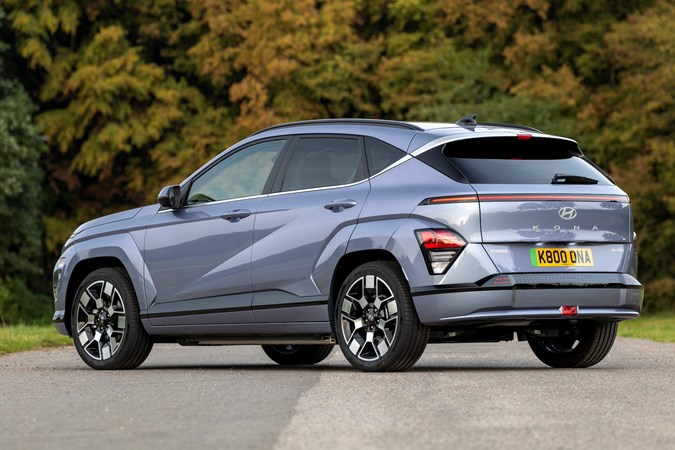
What’s more, it offers increased passenger space, a bigger boot and a modern yet highly functional interior. As an overall package, it has a rounded blend of appeal that that not many of the obvious rivals can match.
Still, there are a lot of these. If you want style, try a Peugeot e-2008. Or if you want cheap, try an MG ZS EV. Premium buyers might like the Smart #1. But even with all these in mind, the latest Hyundai Kona Electric is worth a closer look.
Just as we do with every car we try out at Parkers, we’ve given the Kona Electric a thorough test. If you’d like to find out how we did it, be sure to head over to our page on how we test cars. Or, if you’re the sort of person who prefers to watch rather than read, check out our video review of the Hyundai Kona Electric below, where we pit it against two of its biggest rivals – the Fiat 600e and the Volvo EX30.
Watch our Hyundai Kona Electric review

What’s it like inside?
At first glance, very cliché modern automobile. Meaning that instead of an old-fashioned instrument cluster and separate central infotainment screen there’s now a pair of 12.3-inch panels butted together to form a single flatscreen surface on the top of the dashboard.
Although this is already very driver-eyeline-friendly, there’s also a 12.0-inch head-up display available as well, putting vital info right in front of you. The digital instrumentation is clear enough, and the infotainment is easy to use – but Hyundai’s real user-experience triumph comes from the number of physical buttons, which quickly allow you to hop from one function to another without dicing with a digital menu system.
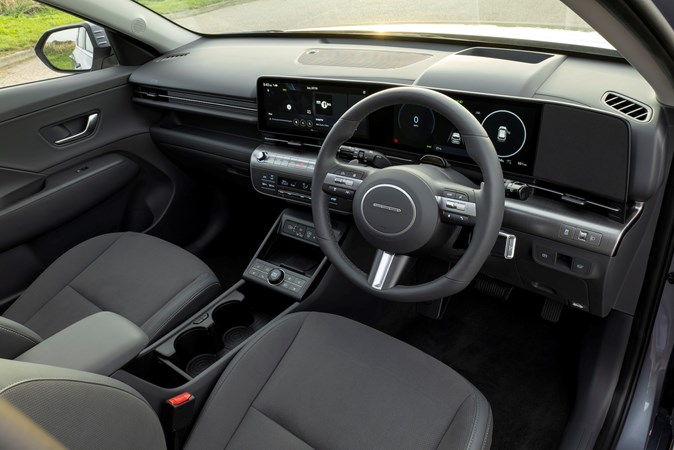
There’s a full set of proper climate controls, too, while the adoption of a column-mounted gear selector frees up more space for stuff in the centre console. There are some cheaper-feeling plastics lower down, but build quality even on early test cars feels robust and free from squeaks and rattles – something the silence of the EV drivetrain would only make more obvious.
Better still, Hyundai has listened to feedback and made this small SUV bigger for passengers. It’s not much larger on the outside than the old one, but there is loads more leg and head room in the back, and a bigger boot, too. Plus you can store your charging cable in a special box under the bonnet.
Hyundai Kona electric motors and batteries
There are two battery and motor variants available in the Kona Electric. Entry-level models – which is only applicable to the cheapest Advance specification in the UK – get a 48kWh battery pack and a 156hp electric motor, while the rest of the range enjoys a 65kWh battery pack and 218hp motor.
We’ve only driven the more powerful package so far, but both versions have 255Nm of torque (pulling power). So although there’s a second’s difference in the benchmark 0-62mph time – 8.8 seconds versus 7.8 seconds – if most of your driving is urban you probably won’t notice much difference (no matter how much effort the engineers have put into the calibration). We’ll update that thought once we’ve driven the lesser model.
Range and charging
The Kona Electric’s maximum charging power isn’t as high as some premium models.
The max charging speed varies with the size of the battery pack, but the main consequence of this is that they should both take 41 minutes to go from 10% to 80% using the public charging network. On a single-phase home wallbox charger, it’ll take 6.0 hours to completely recharge the 48kWh Kona, while the 65kWh model needs 8.0 hours to do the same.
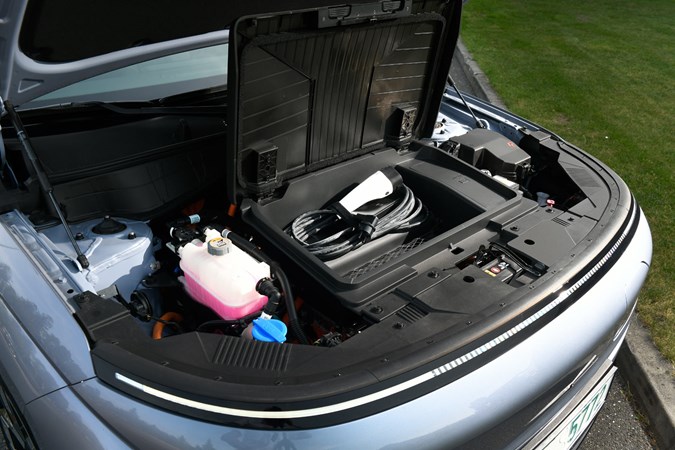
The claimed driving range for the 48kWh Kona Electric is 234 miles per charge, with the 68kWh Kona Electric going 319 miles – both figures according to official WLTP calculations.
We’d expect Hyundai to get reasonably close to those numbers if driven appropriately in the real world – but if you’re foot-to-the-floor everywhere and doing long stretches on the motorway expect to be stopping for coffee and charge more often.
What’s it like to drive?
Hyundai’s whole schtick with the second-generation Kona Electric is that it’s grown up a bit. This manifests itself not just in the increased interior space – which is very welcome – but also the way it drives. The target being greater comfort and improved refinement without losing too much of the original’s agility.
This is pretty much job done, from our experience in the car so far. Gone is the scrappy eagerness of the previous Kona, but so too is much of the road noise – and in its place comes a more assured ride with a less bouncy back end. This immediately makes the Kona feel more mature; in fact, it generally behaves like a much larger car.
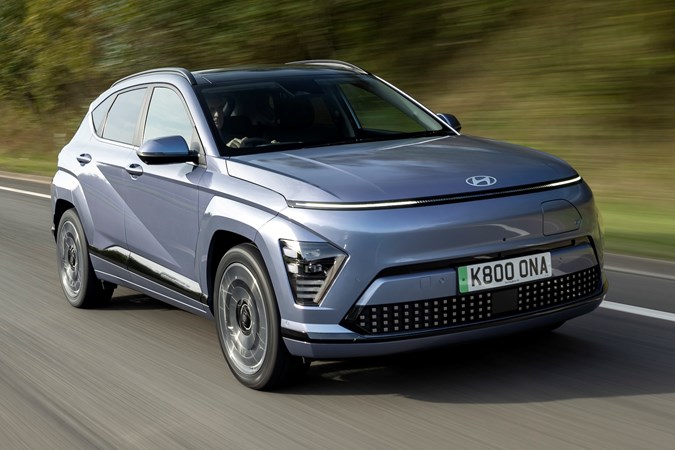
Part of this is because it is a little larger – including the wheelbase (the distance between the front and back axle), which has been extended 60mm – but also thanks to improvements to the structure and more detailed tuning of the chassis and suspension. For instance, the rear subframe is now isolated from the body, while the fundamental vehicle architecture uses more advanced steels and has been carefully strengthened in an effort to eliminate previous weaknesses.
We need to drive it in the UK (inevitably), but it handles occasional surfaces disruptions on the roads around Czechia where it’s built with a detached indifference that bodes well for our more problematic tarmac. Certainly, Hyundai has very much avoided going for an overly firm set-up chasing sporty driving sensations that are largely pointless in such a family orientated vehicle.
That’s not to say the cornering is anything but neat and tidy, mind. There’s not a great deal of feedback at sane speeds, but you can chop it into a turn very late, and unless you’ve really overcooked things the front will happily dig in and execute a smart change of direction with remarkably little body roll. You can also sense the chassis loading-up in faster bends in a manner authentic enough that allows you to make rapid progress without churning too many stomachs.
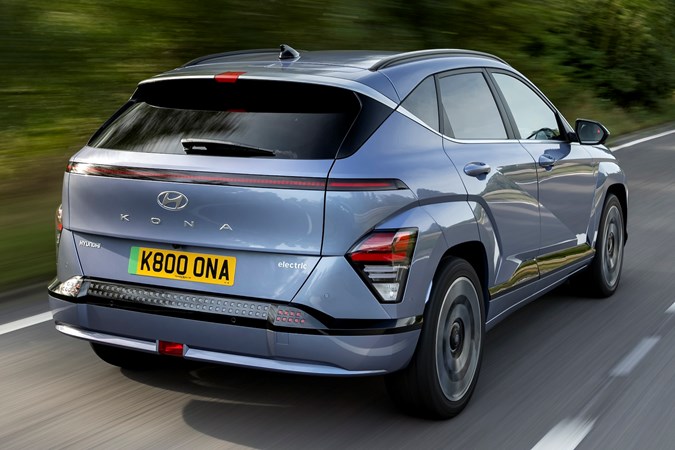
As with many electric cars, the power delivery doesn’t have a great deal of reach – once you’ve hit the performance plateau you can’t drop a gear or two in order scream more momentum out of the engine here. Probably doesn’t matter that much in a small SUV, though it can catch you out when overtaking if you’re not careful; around town the reliably instant response of the single-speed motor drive is ideal for threading through traffic, which is surely a better measure.
What models and trims are there?
We’ve been through the battery and motor options above, which leaves us with the trim levels. There are four for the Kona Electric: Advance, N Line, N Line S and Ultimate.
The Advance isn’t poorly equipped – for instance, it includes 17-inch alloy wheels, dual-zone climate control, keyless go, LED headlights, sat-nav, reversing camera and parking sensors, among many, many other items.
But when you step up to N Line you do start to get kit that seems rather more premium. Examples include heated front and rear seats, heated steering wheel, wireless phone charging, head-up display, ambient lighting, aluminium pedals, 19-inch alloy wheels and powered tailgate.
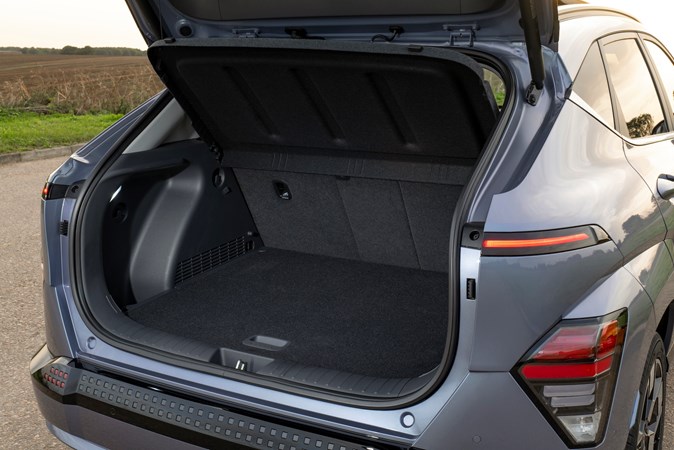
N Line S adds front seat ventilation, electric driver’s seat adjustment, Bose hi-fi and a whole load of extra active safety equipment. Ultimate is essentially the same as N Line S minus the N Line models’ body styling, plus an electric sunroof and different upholstery.
There aren’t a huge number of options but a Lux Pack adds still more safety kit, the ability to unlock and start the Kona Electric with your phone or smartwatch, and a button on the keyfob that will allow you to remotely drive the vehicle in and out of tight parking spaces. That’s some trick kit for such a small car.
What else should I know?
The Mk2 Kona Electric gets one-pedal driving – called i-Pedal – that works well, and means you can drive a lot of the time without touching the brakes; simply releasing the accelerator can often slow the car enough using only the regeneration function of the electric motor. Happily this also returns energy that would otherwise be lost to the battery pack, helping you go further between plugs as well.
Speaking of plugs, the latest Kona Electric also features vehicle-to-load (V2L) technology, allowing you to power other things with the drive battery. Hence there’s a domestic socket in the car alongside all the USB-C ports.
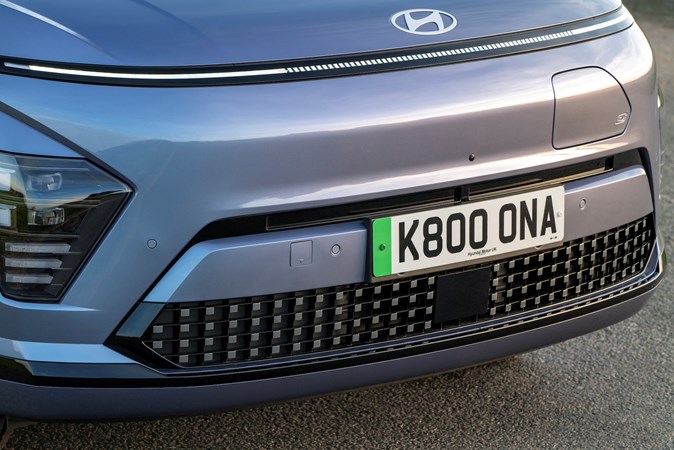
Meanwhile, blindspot cameras show you a view down the side of the car within the instrument cluster whenever you start indicating. This is in addition to the conventional mirrors, and can be filed under tech that isn’t essential but we’ll happily welcome.
Final mention goes to the Driver Status Monitor (DSM). This is a tiny camera pointed at the driver’s face that will cause the car to beep at you if it doesn’t think you’re paying attention or about to fall asleep. Interesting, but it did think we needed to stop for a coffee about two minutes into the drive.
So, has Hyundai cracked it with the Kona Electric? Click through to our verdict page to learn whether you should opt for one of its rivals instead.


